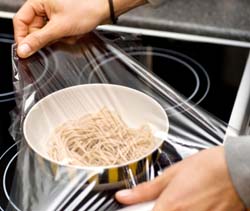From Plastic Wrap to Pyrex, What’s Best?

Be sure what you store your food in keeps it safe to eat
New research is constantly discovering new causes of the world’s most deadly diseases – and more often than most people realize, it is due to poor choices in food storage.
Every day, it seems that leached Bisphenol A (BPA) or Polyvinyl Chloride (PVC) is proven a cause for yet another serious health condition, like cancer or organ damage.
Though many companies have responded to research with healthier ways to store food, it is still important to check every container you use for purity and safety. (If you have children in your home, it’s absolutely essential. Children are the most susceptible to the effects of leached toxins.)
From the worst to the best, here are seven popular ways to store food ranked from the worst to the best choice for safety.
#7 — Polyvinyl Chloride (PVC)
The absolute worst…
Polyvinyl chloride plastic containers are so dangerous they’ve been nicknamed “toxic plastics.” PVC, or vinyl, is one of the worst ways to store food because it is made with DEHA, a type of chemical softener. According to the EPA, exposure to DEHA can cause liver damage, depleted bone mass, and even cancer.
You can usually identify products containing PVC by its resin identification code (the number with the rotating arrows around it). PVC is marked with a number 3 resin code.
#6 — Polycarbonate
Not as bad, but still nasty…
Most often, the number 7 resin code indicates the presence of polycarbonate–and the presence of a health crisis waiting to happen.
You’re probably aware of the debate between researchers, the plastic industry and the FDA over the safety of BPA in plastic products. BPA has been shown to leach out of plastic products and into the food it contains, causing serious problems because of its ability to mimic the hormone estrogen.
Numerous headlines continue to raise alarms about BPA causing cancer, early onset of puberty and childhood obesity. Yet the FDA maintains it is safe to use, even around children.
While the debate rages on, consumers are forced to come to their own conclusions. Since number 7 coded plastics have been used to make hard baby bottles–and even a slight chance that BPA could harm your infant is too much–it’s best to steer clear of this toxic plastic.
Number 7 plastics are also used to make water bottles, cups, cans and food storage liners.
#5 — Plastic Wrap and Bags
No number? No way!
Plastic wraps, sandwich bags and freezer bags aren’t individually marked with resin codes. However, these plastics are known for containing PVC and BPA and can cause many health problems.
#4 — Polystyrene
“They’re” still not sure…
Polystyrene is found in “Styrofoam” containers commonly used as storage for restaurant leftovers.
According to its annual carcinogen report, the National Toxicology Program insists there’s nothing wrong with polystyrene itself. That’s probably because it doesn’t become poisonous until it’s heated and reverts back to styrene, its toxic basic form. The EPA describes styrene as “a suspected toxin to the gastrointestinal tract, kidney, and respiratory system, among others”.
You’re still better to steer clear of polystyrene. And NEVER attempt to heat your food back up in it.
Polystyrene containers are marked with a number 6 resin code.
#3 — BPA-Free Plastics
Pretty good… but what will cause cancer next?
Many companies have removed Bisphenol A from their plastic formulas in an attempt to make them safer. While the effort is noble, what happens when a few years down the line we find out that some other chemical in plastic is even worse for our health than BPA or PVC combined?
In general, it just seems safer and healthier–especially for kids–to avoid plastic for storing food altogether. But if you must use plastic, BPA-Free is the best choice we know of for now.
#2 — Stainless Steel
Much better, but not without controversy.
New companies are springing up that offer stainless steel food storage containers. Considered far safer than plastics, even this sleek option isn’t entirely without debate.
The stainless steel controversy began when it was first offered as an alternative cookware to cast iron, Teflon and copper– all which leach metals and toxins into food over time.
Stainless steel doesn’t have as many terrifying toxins as the plastics listed above. But it’s important to remember that even “food grade” stainless steel is made of iron alloys combined with chromium and sometimes manganese or nickel.
According to a study that tested the leaching of iron, chromium and nickel into food, “stainless steel utensils may put a reasonable amount of iron and chromium trace element into the diet.” And, it concluded, leached nickel did not exceed the EPA recommended amount.
While the study showed trace amounts of metals being leached, avoiding anything that comes apart in your food is a healthy rule of thumb.
#1 – Borosilicate Glass with a Glass Top
The Best Way to Store Food!
Glass is a completely inactive material–it won’t react with food, it won’t deteriorate and it won’t absorb bacteria or toxins. It is also one of the greenest container solutions available since it is 100% recyclable.
Borosilicate glass specifically holds up to extreme temperature changes much better than other types of glass.
Of course, glass is nothing new–it has been used for centuries for everything from jarring harvested fruits to your favorite 9×13 casserole dish. But as a storage option, it hadn’t been perfected until recently.
Because you don’t want any plastic–BPA-free or not–touching your food, the standard airtight lid isn’t going to cut it. The absolute best option would be a glass-on-glass bottom and top set–of course, that’s impossible.
Thankfully, many companies such as Pyrex have come out with a glass-on-glass container solution that uses a silicone rim to maintain an airtight seal to prevent premature spoilage. This is, in our opinion, the healthiest way to store food available today.
Next DON’T MISS…
The Top 3 DIRTY Secrets Lurking in the Pain Relief Industry’s Closet of LIES <== click to see them now!
References
Breyer M. Kitchen Plastic: Easy Greening. Healthy Living. 2008 Feb 2.
The National Toxicology Program. 12th Report on Carcinogens. The Department of Health and Human Services. 2011 Jun 10.
Kumar R, Srivastava PK, Srivastava SP. Leaching of Heavy Metals (Chromium, Iron, and Nickel) from Stainless Steel Utensils in Food Stimulants and Food Materials. Bulletin of Environmental Contamination and Toxicology. 1994 Aug;53(2):259-266.
EPA settles case against Phoenix company for toxic chemical reporting violations. United States Environmental Protection Agency. 2004 Feb 19.


